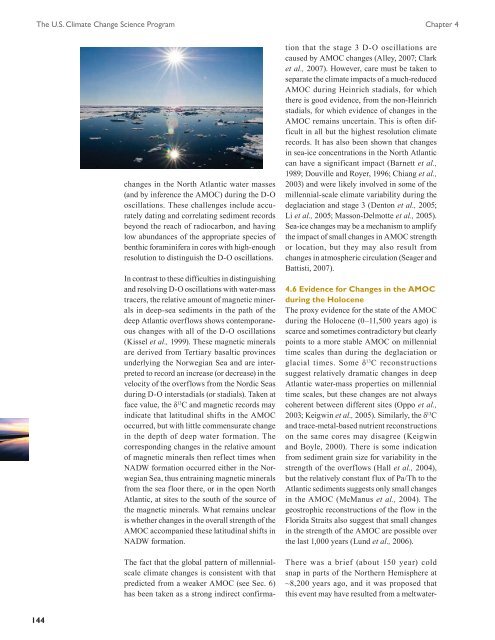Book 2.indb - US Climate Change Science Program
Book 2.indb - US Climate Change Science Program
Book 2.indb - US Climate Change Science Program
- No tags were found...
You also want an ePaper? Increase the reach of your titles
YUMPU automatically turns print PDFs into web optimized ePapers that Google loves.
The U.S. <strong>Climate</strong> <strong>Change</strong> <strong>Science</strong> <strong>Program</strong> Chapter 4changes in the North Atlantic water masses(and by inference the AMOC) during the D-Ooscillations. These challenges include accuratelydating and correlating sediment recordsbeyond the reach of radiocarbon, and havinglow abundances of the appropriate species ofbenthic foraminifera in cores with high-enoughresolution to distinguish the D-O oscillations.In contrast to these difficulties in distinguishingand resolving D-O oscillations with water-masstracers, the relative amount of magnetic mineralsin deep-sea sediments in the path of thedeep Atlantic overflows shows contemporaneouschanges with all of the D-O oscillations(Kissel et al., 1999). These magnetic mineralsare derived from Tertiary basaltic provincesunderlying the Norwegian Sea and are interpretedto record an increase (or decrease) in thevelocity of the overflows from the Nordic Seasduring D-O interstadials (or stadials). Taken atface value, the δ 13 C and magnetic records mayindicate that latitudinal shifts in the AMOCoccurred, but with little commensurate changein the depth of deep water formation. Thecorresponding changes in the relative amountof magnetic minerals then reflect times whenNADW formation occurred either in the NorwegianSea, thus entraining magnetic mineralsfrom the sea floor there, or in the open NorthAtlantic, at sites to the south of the source ofthe magnetic minerals. What remains unclearis whether changes in the overall strength of theAMOC accompanied these latitudinal shifts inNADW formation.The fact that the global pattern of millennialscaleclimate changes is consistent with thatpredicted from a weaker AMOC (see Sec. 6)has been taken as a strong indirect confirmationthat the stage 3 D-O oscillations arecaused by AMOC changes (Alley, 2007; Clarket al., 2007). However, care must be taken toseparate the climate impacts of a much-reducedAMOC during Heinrich stadials, for whichthere is good evidence, from the non-Heinrichstadials, for which evidence of changes in theAMOC remains uncertain. This is often difficultin all but the highest resolution climaterecords. It has also been shown that changesin sea-ice concentrations in the North Atlanticcan have a significant impact (Barnett et al.,1989; Douville and Royer, 1996; Chiang et al.,2003) and were likely involved in some of themillennial-scale climate variability during thedeglaciation and stage 3 (Denton et al., 2005;Li et al., 2005; Masson-Delmotte et al., 2005).Sea-ice changes may be a mechanism to amplifythe impact of small changes in AMOC strengthor location, but they may also result fromchanges in atmospheric circulation (Seager andBattisti, 2007).4.6 Evidence for <strong>Change</strong>s in the AMOCduring the HoloceneThe proxy evidence for the state of the AMOCduring the Holocene (0–11,500 years ago) isscarce and sometimes contradictory but clearlypoints to a more stable AMOC on millennialtime scales than during the deglaciation orglacial times. Some δ 13 C reconstructionssuggest relatively dramatic changes in deepAtlantic water-mass properties on millennialtime scales, but these changes are not alwayscoherent between different sites (Oppo et al.,2003; Keigwin et al., 2005). Similarly, the δ 13 Cand trace-metal-based nutrient reconstructionson the same cores may disagree (Keigwinand Boyle, 2000). There is some indicationfrom sediment grain size for variability in thestrength of the overflows (Hall et al., 2004),but the relatively constant flux of Pa/Th to theAtlantic sediments suggests only small changesin the AMOC (McManus et al., 2004). Thegeostrophic reconstructions of the flow in theFlorida Straits also suggest that small changesin the strength of the AMOC are possible overthe last 1,000 years (Lund et al., 2006).There was a brief (about 150 year) coldsnap in parts of the Northern Hemisphere at~8,200 years ago, and it was proposed thatthis event may have resulted from a meltwater-144






